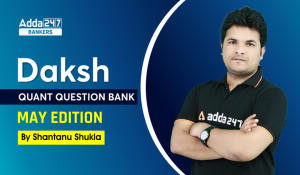Dear Students,
Quantitative Aptitude Questions for IBPS Exam
Today we have been including some Arithmetic Questions. This is the Quantitative Aptitude Questions and you should try to do it within 14-15 Minutes. If you fail to complete it in the stipulated time, then try again with full force. These quantitative aptitude questions are very important from exam point of view like IBPS RRB Exam, IBPS PO and IBPS Clerk.
Q1. In what ratio milk & water should be mixed so that after selling this mixture at its cost price there is a profit of 100/9%?
(a) 8 : 3
(b) 8 : 1
(c) 9 : 1
(d) 4 : 9
(e) None of these
Q2. In a pot, the ratio of milk and water is 4 : 1. In another pot, the ratio of milk and water is 7 : 4. In what ratio mixture should be taken from both mixtures to make final mixture so that in final mixture the ratio of milk and water be 41 : 14?
(a) 3 : 2
(b) 2 : 1
(c) 4 : 3
(d) 5 : 2
(e) None of these
Q3. In a 40 litre mixture of alcohol & water, the ratio of alcohol and water is 5 : 3. If 20% of this mixture is taken out and the same amount of water is added then what will be the ratio of alcohol and water in final mixture?
(a) 5 : 2
(b) 3 : 1
(c) 4 : 1
(d) 3 : 2
(e) 1 : 1
Q4. How much quantity of rice of the price 18 rupees per kg should be mixed with 45 kg of rice having price 26 rupees per kg so that after selling mixture at 25.2 rupees per kg there is a profit of 5%?
(a) 30 kg
(b) 25 kg
(c) 20 kg
(d) 15 kg
(e) None of these
Q5. In what ratio three types of rice whose cost prices are Rs. 5.20, Rs. 5.70 &Rs. 6.40 per kg respectively should be mixed so that of selling this mixture at the rate of Rs. 6.72 per kg there is a profit of 20%?
(a) 2 : 8 : 1
(b) 3 : 6 : 4
(c) 5 : 8 : 3
(d) 7 : 5 : 2
(e) None of these
Q6. Three friends A, B & C started a business by investing on the amount of 10500, 11000 & 12500 respectively. After 9 months, B leaved the business & also C after 6 months. At the end of year, there was a total profit of 24500. Find the share of B in the profit?
(a) 10500
(b) 9500
(c) 8085
(d) 7750
(e) None of these
Q7. Two merchants A & B start a business together. In beginning, A invests Rs. 23250 & after 4 months he debited an amount of Rs. 3750. B invests some amount in starting and drops Rs. 3000 after 7 months. At the end of year, if total profit is divided equally between them then find what amounts B had invested in the start?
(a) 21000
(b) 22000
(c) 20500
(d) 23500
(e) None of these
Q8. A, B, C start a business together. A invests Rs. 20000 for a year. B first invests Rs. 30000 but after 4 months he increases it upto Rs. 40000. In starting, C invests Rs. 40000 but after 9 months he debited Rs. 10000. At the end of year total profit is Rs. 84750. Find the share of A.
(a) 21500
(b) 19000
(c) 18500
(d) 20000
(e) 18000
Q9. P, Q and R enter into the partnership. P advances one-fourth of the capital for one-fourth of the time. Q contributes one-fifth of the capital for half of the time. R contributes the remaining capital for the whole time. How should they divide a profit of Rs. 2280?
(a) 350, 400, 1560
(b) 200, 320, 1760
(c) 400, 500, 1600
(d) 250, 300, 1730
(e) None of these
Q10. A and B invest in the ratio 3 : 5. After 6 months, C joins the business investing an amount equal to B’s. At the end of the year what will be ratio of their profits?
(a) 3 : 5 : 2
(b) 3 : 5 : 5
(c) 6 : 10 : 5
(d) 8 : 10 : 5
(e) None of these
Q11. A boat running downstream covers 24 kms in 4 hours, while for covering the same distance upstream it takes 6 hours. What is the speed of the boat in still water?
(a) 3.5 km/hr
(b) 5.5 km/hr
(c) 6 km/hr
(d) Data inadequate
(e) None of these
Q12. A man can row at 5 km/hr in still water. If the river is running at 1 km/hr it takes him 75 minutes to row to a place and back. How far is the place?
(a) 2.5 km
(b) 3 km
(c) 4 km
(d) 5 km
(e) None of these
Q13. A boat takes half time in moving a certain distance downstream than upstream. What is the ratio between rate of boat in still water and rate of current?
(a) 1 : 2
(b) 3 : 1
(c) 2 : 1
(d) 1 : 3
(e) None of these
Q14. The speed of a boat in still water is 15 km/hr. It can go 30 km upstream and return downstream to the original point in 4 hrs 30 min. The speed of the stream is:
(a) 5 km/hr
(b) 8 km/hr
(c) 10 km/hr
(d) 15 km/hr
(e) None of these
Q15. A man can row three-quarters of a kilometer against the stream in 45/4 minutes and return in 15/2 minutes. The speed of the man in still water is:
(a) 2 km/hr
(b) 3 km/hr
(c) 4 km/hr
(d) 5 km/hr
(e) None of these




 400 Important Quantitative Aptitude Ques...
400 Important Quantitative Aptitude Ques...



